 A magnificent presentation dagger and set of silk robes that belonged to T.E. Lawrence, also known as Lawrence of Arabia, have been placed under a temporary export bar by UK Culture Minister Ed Vaizey. The silver-gilt dagger was a gift from Sherif Nasir, cousin of Emir Faisal, given to T.E. Lawrence in 1917 after the victory of Arab Revolt at the Battle of Aqaba in Jordan. There’s a fictionalized version of the capture of Aqaba and the presentation the dagger in David Lean’s epic film Lawrence of Arabia.
A magnificent presentation dagger and set of silk robes that belonged to T.E. Lawrence, also known as Lawrence of Arabia, have been placed under a temporary export bar by UK Culture Minister Ed Vaizey. The silver-gilt dagger was a gift from Sherif Nasir, cousin of Emir Faisal, given to T.E. Lawrence in 1917 after the victory of Arab Revolt at the Battle of Aqaba in Jordan. There’s a fictionalized version of the capture of Aqaba and the presentation the dagger in David Lean’s epic film Lawrence of Arabia.
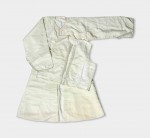 The robes are a champagne silk zebun with a matching waistcoat meant to be worn under the full-length abayeh. The zebun is lined with white cotton and has cotton ties at the waist. The vest has a delicately embroidered brocade button trims. They were made in Mecca or Medina before 1919. Lawrence is depicted wearing the robes in a 1919 oil on canvas portrait by Augustus John.
The robes are a champagne silk zebun with a matching waistcoat meant to be worn under the full-length abayeh. The zebun is lined with white cotton and has cotton ties at the waist. The vest has a delicately embroidered brocade button trims. They were made in Mecca or Medina before 1919. Lawrence is depicted wearing the robes in a 1919 oil on canvas portrait by Augustus John.
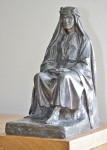 He wore both the garments and the dagger when he posed for Lady Kathleen Scott, sculptor and widow of Antarctic explorer Captain Robert Falcon Scott, for a statuette she entitled Blonde Bedouin. Lawrence was a national hero after World War I, a dashing figure who sat for many artists. Lady Scott was the first and last woman among them. She noted in her diary that she wrote asking him to pose for her and he replied on February 2nd, 1921, that he’d be glad to even though he’d been subject to the scrutiny of so many artists he wasn’t sure there was anything left for her to capture.
He wore both the garments and the dagger when he posed for Lady Kathleen Scott, sculptor and widow of Antarctic explorer Captain Robert Falcon Scott, for a statuette she entitled Blonde Bedouin. Lawrence was a national hero after World War I, a dashing figure who sat for many artists. Lady Scott was the first and last woman among them. She noted in her diary that she wrote asking him to pose for her and he replied on February 2nd, 1921, that he’d be glad to even though he’d been subject to the scrutiny of so many artists he wasn’t sure there was anything left for her to capture.
“Seriously if you want an object, I’ll agree with pleasure: only it won’t be a good speculation: it won’t sell afterwards: and my face isn’t so-to-speak virgin. […] [R]eally the features are quite worn away with so much study of them.
If you do do it, please hold me as a model, and not as ‘the most romantic figure of the war’ (American film-artist). I’m tired of the lime light, and am really not stagy at all, and not ever going to be a public figure again. It was a war effort, imposed, involuntary. Don’t do me as Colonel Lawrence (he died Nov. 11. 1918) but because my shaped head suits your whim.”
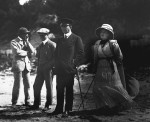 A week later, Lawrence was posing in his Arabic clothing in Lady Scott’s drawing room. He sat for her a total of three times, which was enough to utterly charm the artist. She described him in her diary as “an entrancing child” and declared herself to be suffering from an “acute attack of Lawrencitis.” She became friends with his siblings and even lived with his mother Sarah for a short time.
A week later, Lawrence was posing in his Arabic clothing in Lady Scott’s drawing room. He sat for her a total of three times, which was enough to utterly charm the artist. She described him in her diary as “an entrancing child” and declared herself to be suffering from an “acute attack of Lawrencitis.” She became friends with his siblings and even lived with his mother Sarah for a short time.
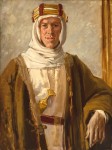 T.E. Lawrence left the robes and dagger with Lady Scott after his departure for the Cairo Conference on February 28th so she could use them to finish the statuette. He didn’t mean for her to keep them forever. On August 28th, 1922, he wrote a letter gently nudging to her return the gear. “There’s a little artist wants to do an Arab picture, & has asked me for kit … Do you think you could provide me some from your store?” If she responded there’s no record of it, and by 1929 Lawrence was yearning at least to get the dagger back. He wrote in a letter to Lionel Curtis dated February 22nd, 1929, that he was “daggerless and near naked” because he had lost two of his three prized daggers and sold the third. He told Curtis: “I will try and see Lady Hilton Young [Lady Scott married Edward Hilton Young, the future 1st Baron Kennet, in 1922] and ask tactfully if she thinks the silver one is hers or not.”
T.E. Lawrence left the robes and dagger with Lady Scott after his departure for the Cairo Conference on February 28th so she could use them to finish the statuette. He didn’t mean for her to keep them forever. On August 28th, 1922, he wrote a letter gently nudging to her return the gear. “There’s a little artist wants to do an Arab picture, & has asked me for kit … Do you think you could provide me some from your store?” If she responded there’s no record of it, and by 1929 Lawrence was yearning at least to get the dagger back. He wrote in a letter to Lionel Curtis dated February 22nd, 1929, that he was “daggerless and near naked” because he had lost two of his three prized daggers and sold the third. He told Curtis: “I will try and see Lady Hilton Young [Lady Scott married Edward Hilton Young, the future 1st Baron Kennet, in 1922] and ask tactfully if she thinks the silver one is hers or not.”
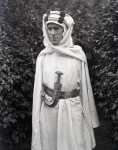 Tact may not have been the approach to take, since it definitely didn’t work in 1922. Whether he contacted her or not, the robes and dagger remained with Kathleen Scott and her descendants until 2015. The family lent the objects out twice: once for a National Portrait Gallery exhibition on T.E. Lawrence, once for an exhibition at the Imperial War Museum. They were only put up for auction last summer after the death of Elizabeth Young, 2nd Lady Kennet, in 2014. The dagger sold for $191,713 and the robes for $19,563 at the same Christie’s auction last July.
Tact may not have been the approach to take, since it definitely didn’t work in 1922. Whether he contacted her or not, the robes and dagger remained with Kathleen Scott and her descendants until 2015. The family lent the objects out twice: once for a National Portrait Gallery exhibition on T.E. Lawrence, once for an exhibition at the Imperial War Museum. They were only put up for auction last summer after the death of Elizabeth Young, 2nd Lady Kennet, in 2014. The dagger sold for $191,713 and the robes for $19,563 at the same Christie’s auction last July.
The buyer asked for an export license, but with this being the only Lawrence dagger left in private hands and with the artistic prominence of the artifacts, the Reviewing Committee on the Export of Works of Art and Objects of Cultural Interest (RCEWA) recommended export be barred to give British institutions the chance to raise the money and keep the robes and dagger in the UK.
RCEWA Chairman Sir Hayden Phillips said:
“Although the depiction, in the film Lawrence of Arabia, of Lawrence leading a sweeping camel charge across the desert into Aqaba in 1917 is probably a romantic exaggeration – stunning though it is – the taking of Aqaba from the landward side, with the help of Auda Abu Tayi, leader of the northern Howeitat, was an extraordinary feat and marked a crucial turning point in the campaign.
“The dagger was presented to Lawrence by Sherif Nasir in gratitude for Lawrence’s leadership and as a spontaneous mark of respect. The robes and dagger together form a crucial part of the images of Lawrence in painting, sculpture and photographs; and they are therefore an integral part of his life and our history.”
Anyone who wants to keep the set in Britain has until April 1st, 2016, to raise £13,000 for the robes and £127,000 for the dagger (prices include VAT), or at least to show a serious effort in that direction. If it looks like they have a chance of raising the money, the Culture Minister can extend the deadline to July 1st, 2016. After that, the license will likely be issued and the dagger and robes will leave the country.